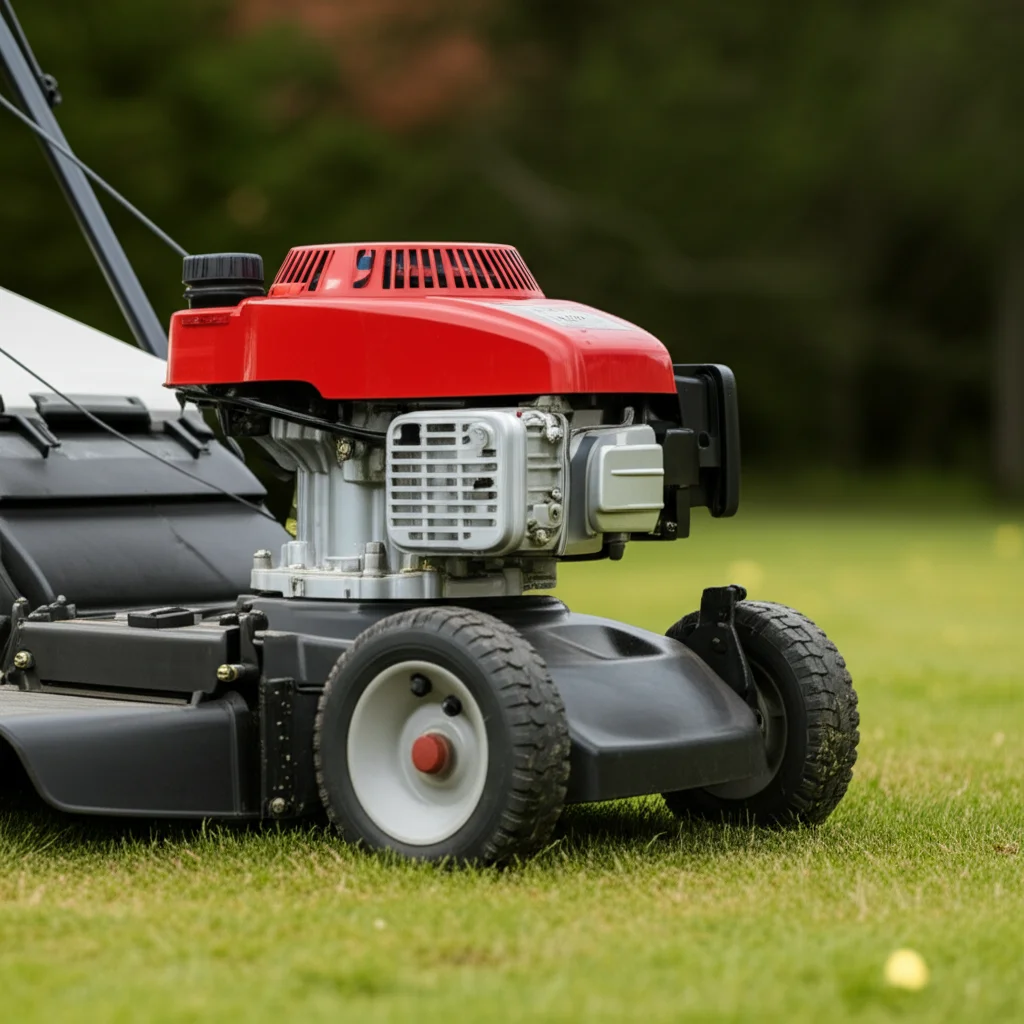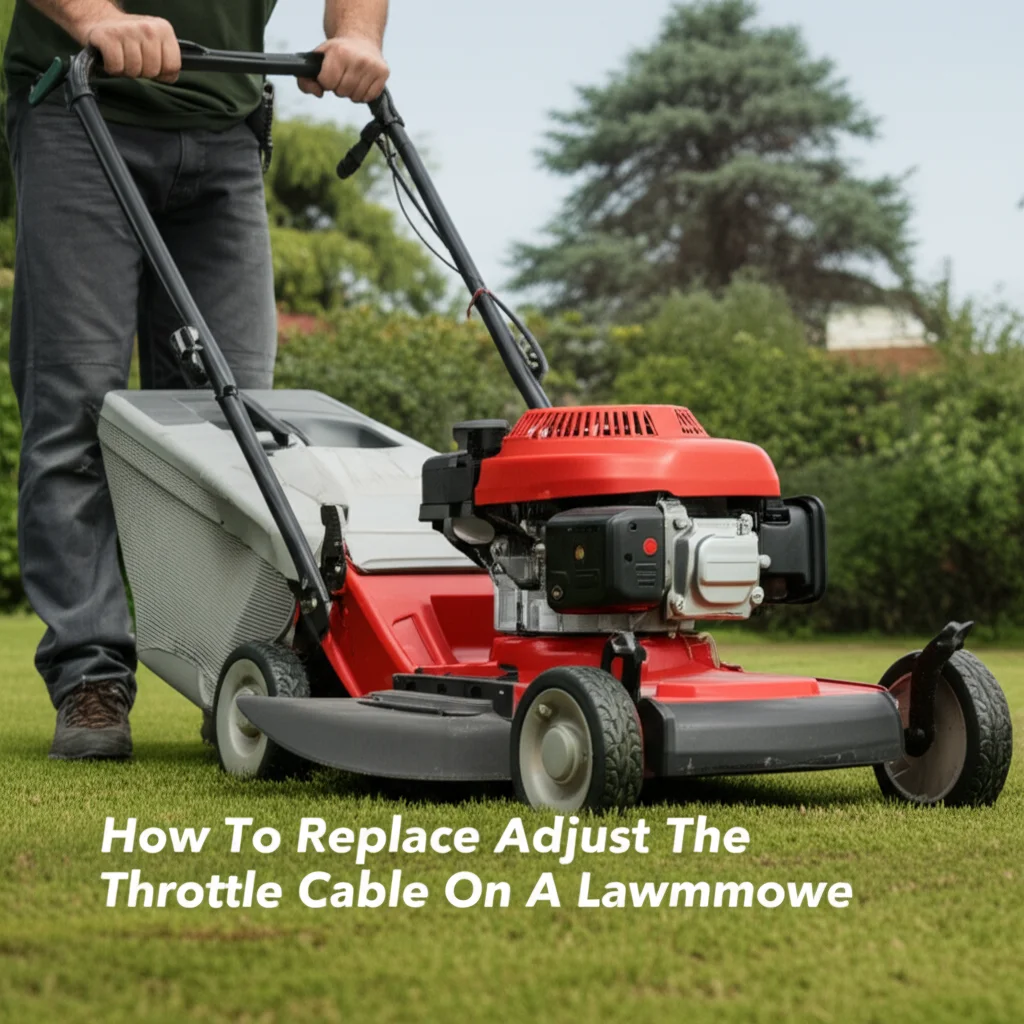· Lawn Mower Maintenance · 10 min read
White Smoke From Lawn Mower When Starting

Lawn Mower String Won’t Pull: Complete Fix Guide
When your lawn mower string won’t pull, it can turn a simple yard maintenance task into a frustrating ordeal. This common problem affects millions of homeowners every mowing season, but the good news is that most pull cord issues have straightforward solutions.
Whether you’re dealing with a stuck starter cord, a rope that won’t retract, or a completely locked pull mechanism, understanding the root causes and proper fixes will get your mower running smoothly again.
Key Takeaways
• Hydro-locked engine from oil overfill is the most common cause of pull cord problems
• Seized internal components due to lack of maintenance can lock up the starter system
• Broken recoil spring prevents the cord from retracting properly after pulling
• Damaged flywheel key can cause timing issues and starter resistance
• Simple maintenance steps like oil changes and spark plug cleaning prevent most issues
Quick Answer: When your lawn mower string won’t pull, the issue is typically caused by a hydro-locked engine from excess oil, seized internal components, or a broken recoil spring mechanism. Start by checking oil levels and removing the spark plug to diagnose the problem.
Understanding Why Lawn Mower Pull Cords Get Stuck
The pull cord system on your lawn mower operates through a simple but effective mechanism. When you pull the starter rope, it engages the flywheel, which turns the crankshaft and initiates the combustion process. Several components work together to make this happen, including the recoil starter assembly, flywheel, and internal engine parts.
Most pull cord problems stem from issues within the engine itself rather than the cord mechanism. When internal components can’t move freely, the resistance transfers directly to the pull cord, making it difficult or impossible to pull. Understanding this connection helps you diagnose problems more effectively.
The starter cord connects to a recoil spring system that automatically returns the rope to its housing after each pull. When this spring breaks or becomes disconnected, you’ll notice the cord doesn’t retract properly, even if the engine turns over normally.
Common Causes of Pull Cord Problems
Hydro-Locked Engine
The most frequent cause of a lawn mower string that won’t pull is a hydro-locked engine. This condition occurs when excess oil fills the combustion chamber, preventing the piston from moving through its normal cycle. Even small amounts of extra oil can create enough resistance to lock up the starter system completely.
Hydro-locking typically happens after overfilling the oil reservoir, tipping the mower at steep angles, or storing the equipment improperly. The oil seeps past the piston rings into areas where it shouldn’t be, creating a hydraulic lock that prevents normal engine operation.
Seized Internal Components
Lack of regular maintenance can cause internal engine parts to seize due to corrosion, carbon buildup, or insufficient lubrication. The piston, connecting rod, or crankshaft may become stuck, preventing the engine from turning over when you pull the starter cord.
This problem often develops gradually, with the pull cord becoming progressively harder to pull before eventually locking up completely. Briggs and Stratton lawn mower pull cord stuck issues frequently involve seized components due to old fuel or moisture damage.
Broken Recoil Spring
The recoil spring mechanism handles the automatic retraction of the pull cord after each starting attempt. When this spring breaks or becomes disconnected, the cord won’t return to its housing properly, and subsequent pulls become difficult or impossible.
A broken recoil spring typically allows the cord to pull out normally on the first attempt but fails to retract, leaving excess cord hanging from the starter housing. This creates binding and prevents proper engagement on subsequent pulls.
Damaged Flywheel Key
The flywheel key is a small metal piece that aligns the flywheel with the crankshaft, ensuring proper timing for ignition. If this key becomes sheared or damaged, it can cause the flywheel to slip out of alignment, creating resistance in the starter system.
Flywheel key damage often occurs when the mower blade strikes a solid object like a rock or tree root, sending shock waves through the drive system. This can cause immediate starting problems or gradual deterioration of starter performance.
Step-by-Step Troubleshooting Guide
Initial Safety Checks
Before attempting any repairs, ensure your safety by disconnecting the spark plug wire and allowing the engine to cool completely. Remove the spark plug entirely to prevent accidental starting during your diagnostic work.
Position the mower on a flat, stable surface and engage the parking brake if equipped. Have basic tools ready including wrenches, screwdrivers, and a socket set appropriate for your mower’s hardware.
Checking Oil Levels
Start your diagnosis by checking the oil level using the dipstick. If oil appears above the maximum fill line, you’ve likely found your problem. Excess oil needs to be drained immediately to prevent further damage to internal components.
Even if oil levels appear normal, check the oil’s condition. Dark, thick, or contaminated oil can contribute to internal seizure problems. Fresh oil should be relatively clear and flow smoothly when poured.
Testing Engine Movement
With the spark plug removed, attempt to pull the starter cord. If it moves freely without the spark plug installed, your problem is likely hydro-locking or compression-related issues. If the cord still won’t pull, you’re dealing with mechanical seizure or recoil system problems.
Try turning the flywheel by hand using a socket wrench on the center bolt. The flywheel should rotate smoothly with consistent resistance. Grinding, catching, or complete resistance indicates internal mechanical problems.
Inspecting the Recoil System
Remove the recoil starter assembly by unbolting it from the engine housing. Examine the spring mechanism for breaks, disconnections, or excessive wear. The spring should be properly wound and securely attached at both ends.
Check the pull cord itself for fraying, stretching, or damage. A damaged cord can bind in the pulley system, preventing smooth operation. What to do when lawn mower string won’t pull quick fixes often involve simple cord replacement procedures.
Professional Repair Solutions
Fixing Hydro-Lock Issues
If excess oil is causing hydro-lock, drain the oil completely and refill with the correct amount according to your owner’s manual. Most walk-behind mowers require 15-20 ounces of oil, while larger engines may need more.
After draining excess oil, pull the starter cord several times with the spark plug removed to clear any remaining oil from the combustion chamber. Reinstall the spark plug and test the starter operation before adding fresh oil.
Addressing Seized Components
Seized internal components often require professional repair or engine replacement, depending on the extent of damage. Minor seizure from old fuel or moisture may respond to penetrating oil and gentle working of the components.
More severe seizure involving scored cylinders or damaged pistons typically requires complete engine overhaul or replacement. Craftsman lawn mower wont start problems often involve similar internal component issues.
Recoil Spring Replacement
Replacing a broken recoil spring requires careful handling due to the spring tension involved. Most recoil assemblies can be disassembled by removing the center screw and carefully releasing spring tension.
Wind the new spring according to manufacturer specifications, typically 4-6 full turns depending on your mower model. Improper spring tension can cause starting difficulties or cord binding problems.
Flywheel and Key Repair
Flywheel key replacement requires removing the flywheel using proper pullers to avoid damage. The old key may be partially sheared or completely broken, requiring careful extraction from the keyway.
Install the new key ensuring proper alignment between flywheel and crankshaft. Torque the flywheel nut to manufacturer specifications to prevent future key damage. Kawasaki lawn mower engine won’t start issues sometimes involve flywheel key problems.
Prevention and Maintenance Tips
Regular Oil Changes
Change your mower’s oil at least once per season or every 25 hours of operation, whichever comes first. Use the oil grade recommended in your owner’s manual, typically SAE 30 for most air-cooled engines.
Check oil levels before each use and never overfill beyond the maximum mark on the dipstick. Overfilling is one of the leading causes of pull cord problems and can damage internal seals and gaskets.
Proper Storage Techniques
Store your mower on level ground to prevent oil migration into the combustion chamber. If you must store the mower at an angle, drain the oil completely first and refill when ready to use.
Stabilize fuel before storage and consider running the engine dry to prevent fuel system problems that can lead to starting difficulties. Why won’t my lawn mower start after winter storage issues often create pull cord problems.
Seasonal Maintenance Schedule
Perform comprehensive maintenance at the beginning and end of each mowing season. This includes oil changes, air filter cleaning, spark plug inspection, and pull cord system checks.
Replace worn components before they fail completely. A frayed pull cord or weakened recoil spring will eventually leave you stranded with a non-starting mower during peak lawn care season.
When to Call a Professional
Complex Internal Damage
If your troubleshooting reveals seized pistons, scored cylinders, or other major internal damage, professional repair may be more cost-effective than attempting DIY fixes. Toro lawn mower won’t stay running problems sometimes indicate internal issues requiring professional attention.
Get repair estimates before authorizing work, as major engine repairs can sometimes cost more than mower replacement, especially on older units.
Safety Concerns
Any repair involving flywheel removal, internal engine work, or electrical components should be handled by qualified technicians if you’re not comfortable with these procedures. Improper repairs can create safety hazards or cause additional damage.
Honda lawn mower revving up and down issues may require carburetor work that’s best left to professionals who have the proper tools and experience.
Frequently Asked Questions
What to do when lawn mower string won’t pull? Start by checking oil levels and removing the spark plug. If oil is overfilled, drain excess immediately. Try pulling the cord with the spark plug removed to determine if the problem is hydro-lock or mechanical seizure.
What causes a pull cord to lock up? Pull cord lockup typically results from hydro-locked engines due to excess oil, seized internal components from lack of maintenance, or broken recoil spring mechanisms that prevent proper cord operation.
What causes a lawn mower to lock up? Lawn mower lockup commonly occurs from overfilled oil creating hydro-lock, seized pistons or connecting rods due to corrosion or insufficient lubrication, or damaged flywheel keys affecting timing and rotation.
What does it mean when the pull cord is hard to pull? A hard-to-pull cord usually indicates increasing compression due to carbon buildup, early stages of component seizure, or worn recoil spring mechanisms that don’t provide proper return tension.
Can I fix a stuck pull cord myself? Many pull cord problems like excess oil drainage, recoil spring replacement, and basic maintenance can be handled by DIY enthusiasts with basic mechanical skills and proper tools.
How do I know if my recoil spring is broken? A broken recoil spring typically allows the cord to pull out normally but fails to retract automatically. You may also notice the cord hanging loose from the starter housing after pulling.
Why won’t my mower start even after fixing the pull cord? After fixing pull cord issues, starting problems may persist due to fuel system problems, spark plug issues, or timing problems from flywheel key damage that occurred during the original failure.
Final Words
Dealing with a lawn mower string that won’t pull doesn’t have to derail your lawn care routine. Most pull cord problems stem from simple maintenance issues like excess oil or worn components that can be addressed with basic mechanical skills and proper tools. By understanding the common causes and following systematic troubleshooting steps, you can quickly identify and resolve most starter cord issues.
Remember that prevention through regular maintenance is always more cost-effective than emergency repairs. Keep your mower properly serviced, store it correctly, and address small problems before they become major failures.
When in doubt, don’t hesitate to consult with a qualified repair technician who can ensure your mower operates safely and reliably for years to come.
- lawn mower repair
- white smoke
- lawn mower troubleshooting
- engine problems
- small engine repair



